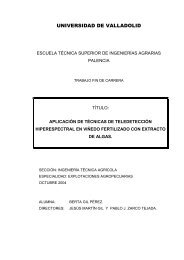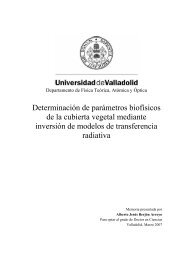10th INTERNATIONAL VERTICILLIUM SYMPOSIUM 16-20 ...
10th INTERNATIONAL VERTICILLIUM SYMPOSIUM 16-20 ...
10th INTERNATIONAL VERTICILLIUM SYMPOSIUM 16-20 ...
You also want an ePaper? Increase the reach of your titles
YUMPU automatically turns print PDFs into web optimized ePapers that Google loves.
NON-CHEMICAL CONTROL OF <strong>VERTICILLIUM</strong> ANDNEMATODES IN TREE NURSERY SOILSG.W. KORTHALS 1 , J.H. VISSER 1 , B.J. VAN DER SLUIS 2 , A.P. SMITS 2 ANDJ.A. HIEMSTRA 2Applied Plant Research PPO, Wageningen University, The Netherlands1 Section Arable Farming, Multifunctional Agriculture and Field Production of Vegetables, P.O. Box430, 8<strong>20</strong>0 AK Lelystad, The Netherlands2 Nursery Stock section, P.O. Box 85, 2<strong>16</strong>0 AB Lisse, The NetherlandsE-mail: jelle.hiemstra@wur.nl and gerard.korthals@wur.nlVerticillium wilt caused by V. dahliae is a serious problem in tree nurseryindustry in the Netherlands. Total loss of value due to Verticillium wilt recently wasestimated to be about 5 million euro annually, mainly in the production of street treesand roses. The only effective control of Verticillium wilt in trees is to prevent thetrees from being infected. V. dahlia, however, is widely spread in agricultural fields inthe Netherlands and many important tree species are susceptible to Verticillium wilt.Therefore effective methods to eradicate the fungus from soil are strongly needed.The recent withdrawal of most soil fumigants due to their negative environmentaleffects enhanced the interest for new non-chemical techniques in the control ofVerticillium and nematodes.In <strong>20</strong>09 PPO started a long-term field experiment to develop new strategies tocontrol Verticillium dahliae and the nematode Pratylenchus penetrans in tree nurserysoils. Biological methods applied are anaerobic biological soil disinfestation, growingmarigold (Tagetes patula) combined with the application of compost, and growing agreen manure crop (Sarepta or Indian mustard, Sinapis juncea), which will beincorporated in the soil to cause biofumigation. These treatments will be comparedwith two control techniques, fallow and chemical soil disinfestation (Metam-Sodium),and with growing white clover (Trifolium repens). In the clover treatment it isexpected that both Verticillium dahliae and the nematode Pratylenchus penetrans willincrease in the soil, since clover is a good host for both pathogens.The treatments will be applied during <strong>20</strong>09 to experimental plots on twodifferent soil types. In <strong>20</strong>10 on these plots roses (on sandy soil) and Acer platanoides(on clayey soil) will be grown to investigate the effectiveness of the different methodsin the control of Verticillium dahliae and the nematode Pratylenchus penetrans.Besides growing these test crops, several techniques including plating of soil samplesand the use of molecular detection techniques will be used to monitor the populationdensities of Verticillium dahliae and the nematode Pratylenchus penetrans in the soilduring the whole project.104




